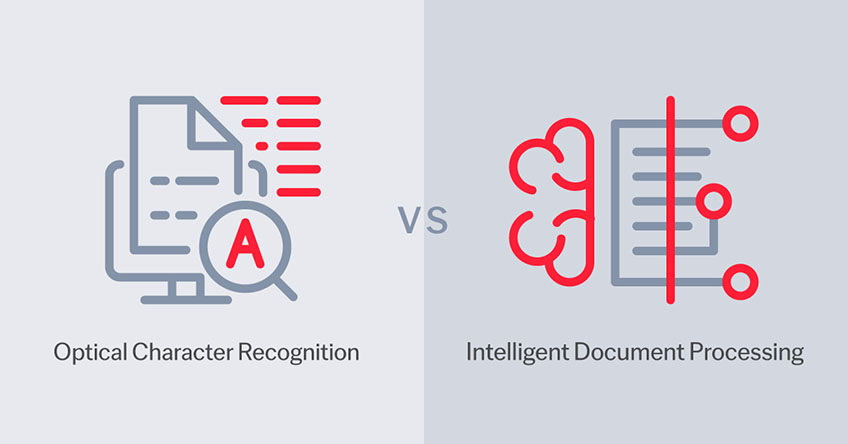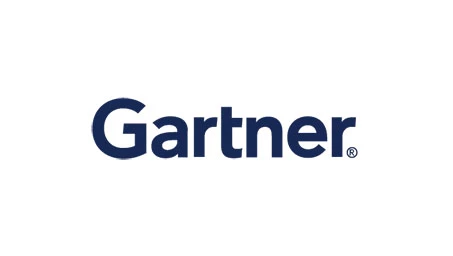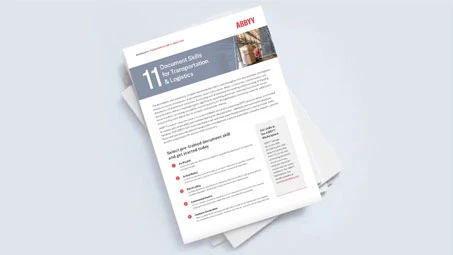
OCR vs. IDP: What’s The Difference?
Slavena Hristova
July 29, 2024

Optical character recognition (OCR) is primarily focused on recognizing characters and converting images/pictures of text into editable text, while intelligent document processing (IDP) takes this a step further by integrating OCR technology along with other intelligent processing techniques to automate the entire document management and workflow process.
Prior to OCR you would need to manually type text to input data into a computer system. OCR software analyzes the characters in an image, extracts them, and translates them into machine-readable, editable text. IDP incorporates OCR to recognize the characters and uses artificial intelligence (AI) and machine learning to read and interpret the text and extract valuable information and process that information like a human to complete a business process, for example review an invoice and forward it for payment. IDP can handle a wider variety of content including structured and unstructured information to automate a whole range of document-based workflows to take companies through digital transformation.
What is OCR?
OCR stands for optical character recognition. OCR technology is used to analyze, read, and extract text in scanned documents or images and convert it into machine-readable text. It is often used to digitize printed books and articles, or in business processes involving physical documents, such as invoices and receipts, so that the text content can be edited, searched, and stored electronically. OCR technology is typically integrated with other applications, such as IDP, as one step of a larger process of intelligent automation.

How it works
OCR starts with the file that you want to extract information from, which may be a scanned document, a PDF, or photographs of paperwork. Modern OCR platforms can automatically enhance quality, add contrast, and sharpen resolution to improve accuracy. Next, the OCR algorithms will use pre-trained extraction models to identify words and lines in the image and extract individual characters it recognizes.
The extracted data is then matched against a set of predefined patterns or templates representing known characters and symbols. To do this, it may incorporate technologies such as machine learning and neural networks to improve recognition accuracy and handle different fonts and languages, or complicated layouts such as tables and lists or barcodes. If it encounters a problem, it may flag it for human evaluation. Once the character recognition process has been completed, you may need to check for errors or improve accuracy by using spell-check, context analysis or language modeling. The OCR software will then produce the final machine-readable text that can be integrated into your company’s computer system.
Benefits of OCR
OCR is an essential technology for every industry working heavily with documents, be it the day-to-day work that employees have with their current documents, digitizing archives, or creating accessible digital document repositories by processing a large volume of documents, for example, batches of healthcare documents or logistics documentations.
Businesses can benefit from OCR tools in a variety of ways.
- Increased productivity and performance. Alleviate manual work of data entry and retyping. A typical document containing about 300 to 500 words takes approximately 10 minutes for a person to manually copy—on the other hand, OCR can do this task in about 10 seconds, reducing time spent on physical paperwork by 75 percent.
- Accuracy rates as high as 99.8 percent. That is much more accurate than humans who tend to make more mistakes.
- Increased security and improved compliance. Physical documents are more likely to be lost, stolen or damaged and digitizing documents provides more secure storage. Additionally, image-based digital documents (scans, image-only PDFs) are not searchable without OCR, therefore those formats do not comply with accessibility requirements.
- Cost savings. OCR solutions provide accurate data capture and effective digitization, lower the risk of costly human errors that can derail processes and lead to financial penalties.
Common use cases for OCR solutions can include organizations to facilitate compliance with government and corporate regulations by converting large volumes of paper and digital documents into accessible and searchable formats, legal firms converting paper contracts into editable digital formats for search, eDiscovery, and data analysis, healthcare companies transferring patient records onto their computer system maintaining HIPAA compliance, libraries and archives preserving historical documents in digital form enabling employees across an organization to perform their various daily document-related tasks effectively, software developers to create content services, digital archiving, document management system (DMS), enterprise content management (ECM) solutions, and many others.
What is IDP?
Intelligent document processing (IDP) enables straight-through processing of documents by automatically capturing, extracting, and processing data embedded in business documents, in just about any process in any industry.

How it works
IDP incorporates optical character recognition (OCR) to convert printed or handwritten text into typed text/machine-readable format. IDP also applies artificial intelligence (AI) and machine learning (ML) techniques to read, understand and process structured, semi-structured, and unstructured data in documents like a human.
IDP uses machine learning models to classify documents into different categories based on their content, layout, or other characteristics. For example, invoices might be categorized as "Invoices," contracts as "Contracts," and so on. The categorized documents are then passed on to pre-trained extraction models, which analyze and understand the data within the document in a human-like manner and are capable of extracting business-critical information. The data can be validated against specified rules or, for example, a company database of clients, and if it encounters problems, it can flag it for human assessment. This so-called human-in-the-loop (HITL) feedback enhances the extraction models, which are constantly learning and improving based on manual corrections.
By incorporating natural language processing (NLP) the technology is also able to interpret the context of the information it is reading. For example, is the word “jaguar” referring to a large cat or a car? Or is the word ‘Sue’ referring to a person or a legal action? By applying NLP, an unprecedented recognition of unstructured data is identified and extracted, and can operate like a human brain, quickly adapting to changing input, and generating the best possible result. This sort of advanced level of technology is known as intelligent automation or hyper automation.
The IDP platform can be easily integrated into a variety of different business systems, such as ERP, or CRM. With new low-code/ no-code platforms, citizen developers can deploy IDP technology in a matter of days without need for massive IT infrastructure support and maintenance on client’s side.
Benefits of IDP
Across all industries, businesses are facing pressure to do more—and do it faster—with fewer skilled resources. Organizations are focusing on improving experiences for customers and employees as a key to improving revenue, margins, and retention. Intelligent document processing (IDP) can deliver significant benefits on both counts, enabling companies to achieve successful digital transformation.
IDP technology closely mirrors the way humans understand and manage documents, saving time and money, while also reducing the risk of costly errors.
Significant benefits of IDP include:
- Times saving and enhanced efficiency. Particularly for industries that handle high volumes of paperwork such as financial services, healthcare, logistics and legal. With IDP invoice processing times can be reduced by as much as 90 percent, equating to a 400 percent increase in employee productivity. That was the case with Metro AG which uses ABBYY’s intelligent document processing to reduce the turnaround time for invoices from an average of one to two days to just one hour.
- Improved accuracy. Machines don’t get distracted or tired and make costly mistakes like humans. Fewer errors and faster operations are realized with IDP.
- Better customer service. Faster processing times, more accurate data handling, and quicker response to client queries contribute to an overall improved customer experience, which can lead to higher customer satisfaction and loyalty.
- Faster decision making. By rapidly processing and extracting insights from documents, IDP enables faster decision-making. This is particularly beneficial for industries where timely decisions can have a significant impact, such as finance and customer service.
- Better security and compliance. IDP can help enforce compliance by ensuring that documents are processed according to established rules and regulations.
- Scalability. As business operations grow, the volume of documents to be processed also increases. IDP solutions can easily scale to handle larger document volumes without a proportional increase in labor costs.
- Easy integration to company workflow. IDP can be integrated with other digital systems and workflows to enable seamless and efficient digitization of business processes across company departments and your entire organization.
What’s the difference between OCR and IDP?
OCR has been around for a long time and is known as a document capture-related technology. OCR is primarily used to extract text from paper documents, scanned images or photographs and convert them into typed text that can be edited digitally on a computer.
The technology is commonly used to digitize printed documents to make them accessible electronically, for example a scanned letter that may be uploaded, to change the name and address of the recipient. However, OCR does not understand the meaning of the text, it just focuses on recognition of the characters.
IDP, on the other hand, incorporates a broader range of capabilities and technologies which make it smarter. IDP not only uses OCR for character recognition, it also incorporates artificial intelligence (AI) and machine learning to read and understand what the text means and thus be able to use it to make decisions on its value and know what to do with it.
For example, it may read an invoice, take its content to be compared to a corresponding purchase order, compare the sums for accuracy, and then forward it to the head of finance for payment. IDP can handle complex document types and process structured, semi structured or unstructured data just like a human. It also learns from its mistakes through the use of machine learning.
| OCR | IDP | |
| What it does | “Reads” scans and images of documents and converts them into machine-readable, searchable documents and/or text. | Extracts meaningful data from structured (forms), semi-structured and unstructured documents to power intelligent automation. |
| How it works | Applies AI algorithms to transform analog paper documents into digital text incl. document structure and segmentation (text, images, tables, barcodes, checkmarks, signatures, lines, characters, fonts, font sizes, language, etc.). | Uses the full-text provided by OCR as basis input and applies AI, NLP, ML regular expressions, and rules to understand the information in the document and extract tagged, meaningful data which can be passed onto down-stream business applications for informed decision-making. |
| Technology | Image enhancement Object detection OCR / ICR |
|
| Typical use cases | Provides access to machine-readable text as basis for: PDF conversion Digital archiving / Search eDiscovery Advanced search / Digital forensics Data analysis Intelligent document processing (IDP) | Automation of any document-centric business process: Accounts payable automation Customer onboarding / KYC Loan processing Automation of transportation & logistics documentation Insurance claims processing |
Examples of OCR and IDP in business processes
Invoice processing
Compared to manual invoice processing, automated invoice processing is drastically faster—by as much as 81 percent. This translates into fewer late payments and more opportunities to take advantage of early payment discounts. It also expedites audit procedures. For example, international wholesale company Metro AG was able to reduce its invoice processing cycle by 90 percent.
Form processing
Every industry has a host of forms that need to be processed. In the insurance sector it may be claims forms, in logistics it could be driver logs or delivery receipts, and in banking it might be credit card applications or mortgage and loan forms. Automating forms means you reduce the time spent reading, processing, and transferring information to your workflow process.
It eliminates costly, time-consuming, and error-prone manual data entry, improves performance and increases efficiency.
Customer onboarding
Research shows that 90 percent of organizations see potential customers abandon the digital registration process–with the top complaints from applicants being that it takes too long and there is too much data input.
With intelligent document processing, you can take away the bottlenecks that lead to abandonment. Businesses can leverage IDP technology for identity proofing and identity affirmation, which make it easier for customers and more secure for businesses. IDP can capture and classify ID documents like driving licenses or passports, or supporting documents like bank statements or utility bills, that are needed for proof of address. For example, it can be used by the department of motor vehicles (DMV) for a driver license renewal or a bank for mortgage applications.
OCR vs. IDP: Which is best for your business?
OCR can sometimes be mistaken as an IDP platform, when, in fact, IDP has far broader capabilities. OCR focuses primarily on extracting full text from images and documents so that it can be transferred and edited on a computer screen. It recognizes different font styles, images and handwritten notes and translates them into editable and searchable digital text. For businesses looking for digital archiving solutions or to create assistive technologies that require excellent text recognition, PDF conversion, and data capture functionalities, an OCR solution is best-suited. You can get excellent document capture functionalities with ABBYY’s OCR Software Development Kit. (SDK)
IDP encompasses OCR technology but goes one step further by analyzing and interpreting the text like a human can. It uses advanced technologies like natural language processing, machine learning and artificial intelligence to understand the content of documents in a more comprehensive manner. IDP therefore is not only extracting the text but providing context understanding, data validation, and decision-making based on the information it finds. IDP is more suitable for organizations that require sophisticated document processing, workflow automation and decision-making based on content. Now with new low-code/no-code solutions, such as ABBYY Vantage, companies can use IDP out of the box with pre-trained, ready-to-go document processing models or instead quickly and easily create their own extraction models based on document types or requirements specific to their business needs.
Frequently asked questions
Does IDP use OCR?
Yes, OCR is a fundamental part of many IDP systems, especially when dealing with scanned or image-based documents, as it can read images of text (such as scanned documents or photos of handwritten text).
While OCR helps to extract text and data from documents, the information is then processed and analyzed by AI algorithms in IDP to perform tasks like data validation, data entry automation, document categorization, continuous learning from feedback, and more.
What’s the advantage of using IDP instead of OCR?
IDP goes beyond basic character recognition. It combines OCR with advanced AI techniques, such as natural language processing (NLP) and machine learning, to understand the content and context of the document. This allows IDP to extract not only text, but also the meaning and relationships between different elements in the document.
Here are a few advantages of IDP over OCR:
Better Extraction Accuracy: While OCR focuses on converting images of text into machine-readable text, IDP enhances accuracy by cross-referencing extracted data with databases, previous records, and contextual information. This reduces errors in data extraction and interpretation.
Structured and Unstructured Data: IDP is capable of handling both structured and unstructured data. It can process forms, tables, invoices, contracts, and other types of documents, extracting data in a structured format. OCR, on the other hand, is more suited for simple full text extraction from images.
Automated Workflows: IDP can be integrated into automated workflows and business processes. It can perform tasks like document classification, data extraction, validation, and routing, reducing the need for manual intervention. This can lead to increased efficiency and reduced processing times.
Adaptability and Learning: IDP systems continuously learn from user interactions and feedback - human-in-the-loop (HITL) input. Over time, they can improve their accuracy and understanding of specific document types, making them adaptable to changing document formats and content structures.
Complex Document Types: IDP has added capabilities to handle documents that involve complex structures, where data extraction requires understanding the relationships between various pieces of information. This includes documents with multiple languages, formats, and varying layouts.
Regulatory Compliance: IDP can help organizations ensure compliance with regulatory standards by accurately extracting and managing critical information from legal documents, contracts, and compliance-related forms. These can then be matched against predefined business rules.
What is the difference between OCR and image processing?
Image processing is used as a pre-step to OCR to prepare the image for optimal text extraction, for example removing speckles or water marks or adjusting brightness and contrast for a clearer picture. Image processing can also involve extracting features, detecting certain objects, and performing various transformations to make images more useful for specific applications.
What is cognitive RPA and how do OCR and IDP technologies play a role?
Cognitive Robotic Process Automation (Cognitive RPA) refers to the integration of Robotic Process Automation (RPA) technology with cognitive capabilities, such as artificial intelligence (AI), machine learning (ML), natural language processing (NLP), and optical character recognition (OCR). This is also referred to as intelligent automation.
OCR (optical character recognition) and IDP (intelligent document processing) technologies play crucial roles in enhancing the cognitive capabilities of RPA systems. IDP enables RPA systems to not only extract data from documents but also understand the context and meaning of the information. This advanced processing capability allows RPA bots to perform more complex and human-like tasks such as processing of unstructured or semi-structured documents more intelligently. For example, an IDP-enabled RPA bot can extract data from an invoice, validate the information against predefined business rules, and make decisions based on the extracted content, or it may analyze a legal contract to identify key terms, obligations, and deadlines.






